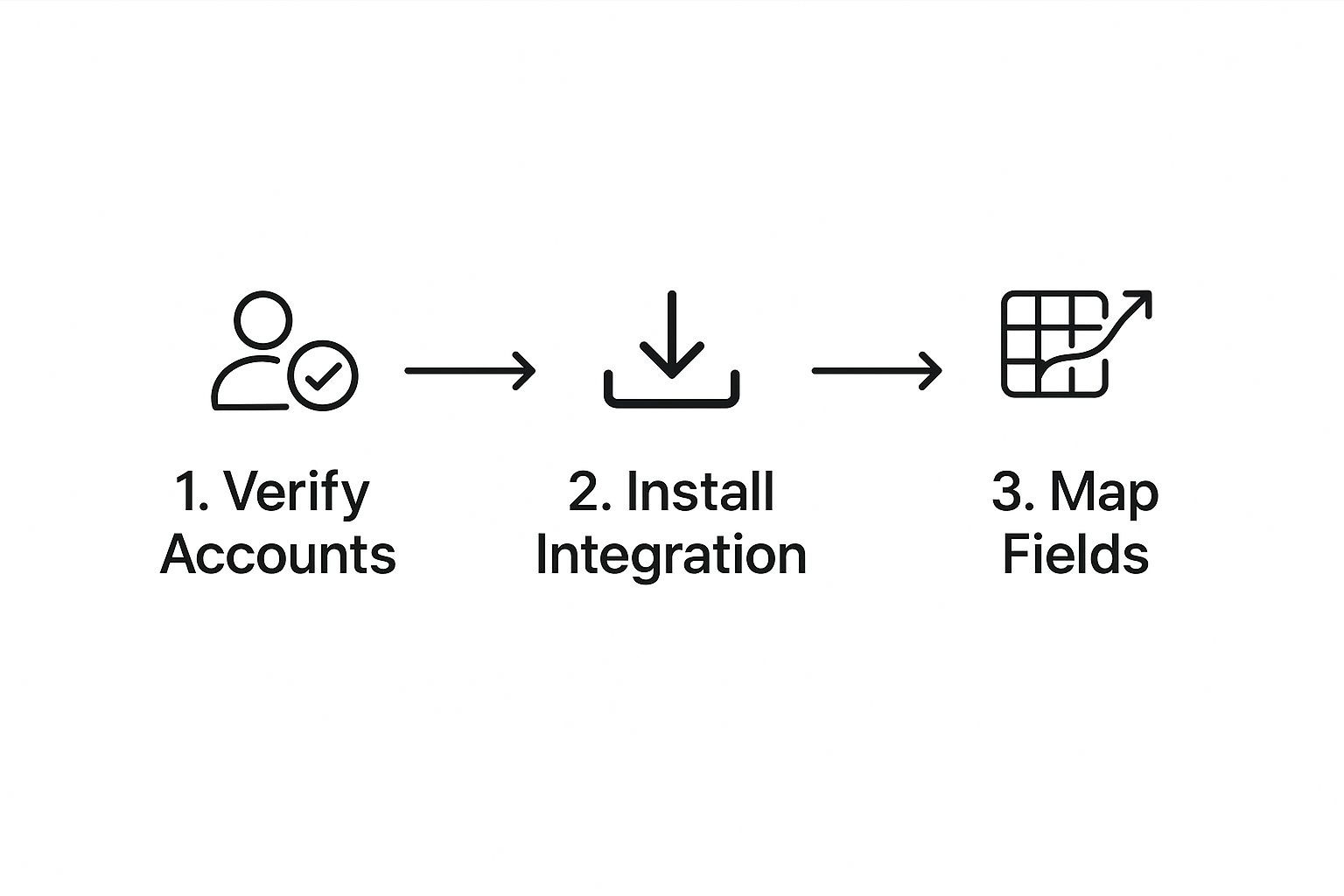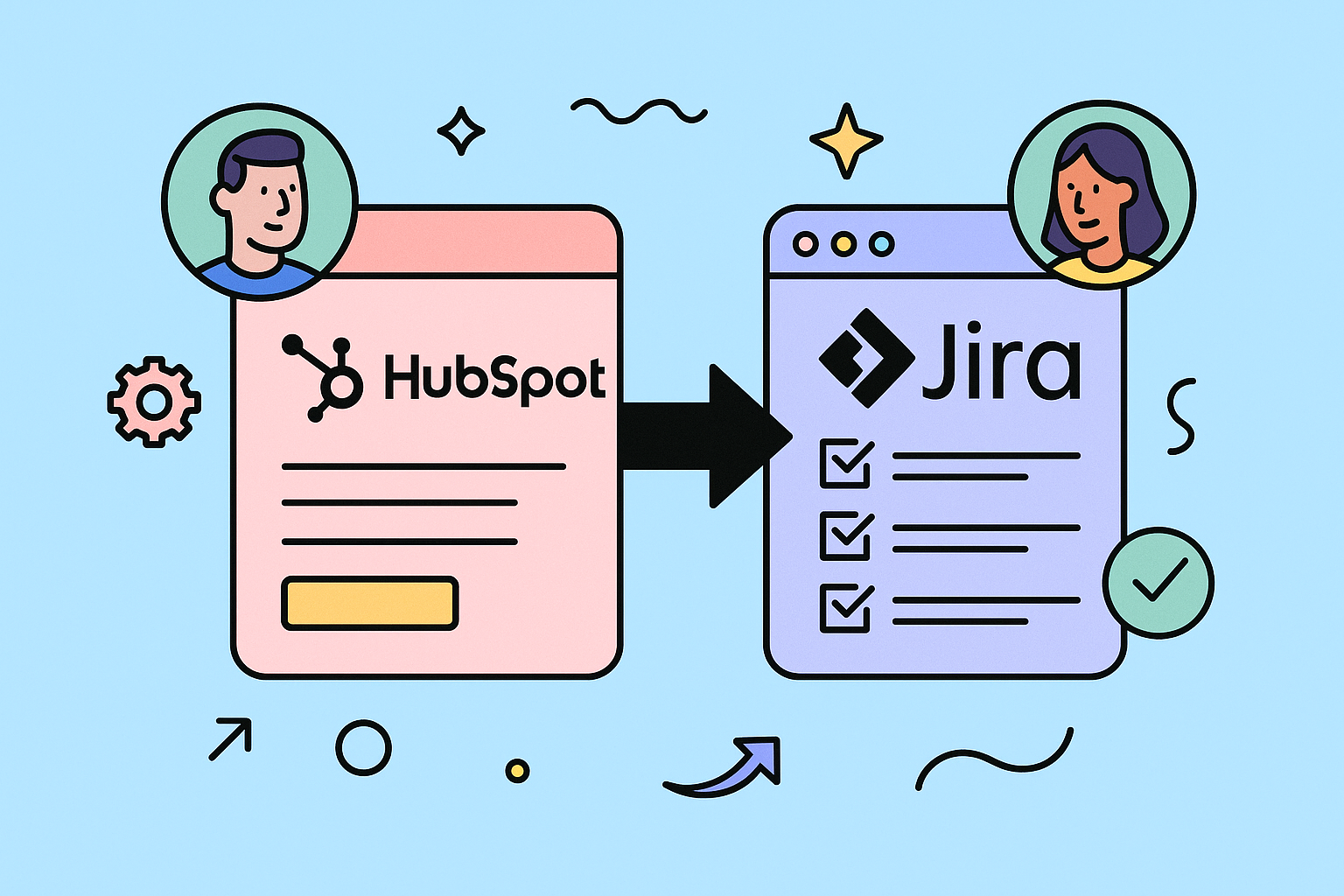Picture this: your sales and development teams, finally operating from a single source of truth. The constant back-and-forth, the missed updates, the lost context—gone. This is what happens when you embed HubSpot data directly into Jira. You’re not just connecting two platforms; you’re bridging the huge gap between customer-facing activities and the technical teams who build and fix your product.
Why Connecting HubSpot and Jira Changes Everything
Let’s be honest, the disconnect between sales, support, and development teams is a classic source of friction. Sales reps are closing deals in HubSpot, support agents are wrestling with customer issues, and developers are deep in their Jira backlogs. Without a direct link, critical customer context gets lost in translation. This leads to tedious manual data entry, duplicated work, and frustratingly slow response times.
Integrating these two powerhouses isn’t just a technical tweak. It’s a strategic decision to build a unified workflow that puts the customer at the absolute center of every task.
Break Down Those Information Silos
When you embed HubSpot data in Jira, a developer working on a bug fix can instantly see the whole story. Is this bug derailing a massive deal for a high-value client? Or is it a minor annoyance for a new prospect just kicking the tires?
This kind of visibility is a game-changer. It empowers your teams to prioritize work based on real-world business impact, not just technical severity.
Suddenly, everyone can make smarter decisions:
- Product Managers can tap into direct customer feedback from HubSpot tickets to shape a roadmap that people actually want.
- Support Agents can see the real-time status of a bug fix in Jira without ever leaving the HubSpot ticket they’re working on.
- Developers finally get the “why” behind their tasks, which fosters a much stronger sense of purpose and connection to the customer.
The goal is to stop forcing your teams to hunt for information across different apps. When you give them shared data, they can focus on what they do best: solving problems together and serving customers.
Drive Real, Measurable Efficiency Gains
Automating the information flow between HubSpot and Jira delivers some serious productivity wins. We’ve seen that when teams sync HubSpot tickets with Jira issues automatically, they can slash human errors from manual data entry by up to 30%.
Even better, this alignment can lead to an approximate 40% reduction in the average time it takes to resolve a ticket. Why? Because everyone is finally on the same page, working from the same up-to-date information. No more chasing people for updates.
For anyone who’s lived through the pain of manual workflows, the benefits of this integration are immediately obvious. Here’s a quick breakdown of how it transforms daily work for different teams.
How HubSpot-Jira Integration Transforms Team Workflows
A quick look at the immediate benefits your teams will experience after connecting HubSpot and Jira, highlighting the shift from manual tasks to automated efficiency.
| Team Role | Common Pain Point (Manual Workflow) | Integrated Solution (Automated Workflow) |
|---|---|---|
| Developer | “Why am I working on this? I have no context about the customer or the business impact.” | Sees linked HubSpot deals and tickets in Jira; understands task priority based on revenue or customer impact. |
| Support Agent | “I have to constantly ping the dev team on Slack for an update on this bug fix for my customer.” | Views the live Jira issue status directly from the HubSpot ticket, providing instant updates to customers. |
| Sales Rep | “I need to know if that critical feature for my prospect is being built, but I don’t have Jira access.” | Can see the linked Jira issue progress from within the HubSpot deal, keeping the prospect informed. |
| Product Manager | “I have to manually compile feedback from sales calls and support tickets to justify roadmap items.” | Gathers quantitative data by seeing how many customers and deals are linked to a specific feature request in Jira. |
This simple connection is what turns isolated data points into a powerful, collaborative engine. It’s the foundation for transforming customer insights into actionable development work.
To explore this strategy further, check out our guide on how the HubSpot Jira integration helps align your teams. It’s the first step toward delivering a truly superior customer experience.
Preparing for a Flawless Integration

A successful integration starts long before you ever click “install.” I’ve seen it happen time and time again: teams jump in without a clear plan, and they end up with a clunky tool that nobody uses. This initial groundwork is what separates a frustrating setup from one that delivers real strategic value from day one.
Think of it as your pre-flight checklist.
First things first, you need to confirm you have the right permissions. To connect these platforms, you must be a super admin or have App Marketplace permissions in your HubSpot account. Over in Jira, you’ll need administrative access to your Jira Cloud account to install and configure new apps. Getting this sorted out upfront prevents those “access denied” headaches later on.
Define Your Data Mapping Strategy
Once permissions are squared away, the real planning begins. You can’t just embed HubSpot data in Jira and expect magic to happen; you need to be precise about what information actually matters to your teams. This is a critical conversation that should absolutely involve people from sales, support, and engineering.
Get these key players in a room (or on a video call) and ask some pointed questions:
- To Your Developers: What single piece of customer info would help you prioritize your work more effectively? Is it the deal size? The customer’s subscription tier? Or maybe the number of support tickets they’ve logged?
- To Your Support Agents: When you escalate a bug to engineering, what context from HubSpot do you always find yourself copying and pasting? This is often the original customer complaint or their contact details.
- To Your Sales Reps: What update from the dev team would be most valuable to see inside a HubSpot deal record? A Jira issue status flipping from “In Progress” to “Done” could be a massive buying signal.
The answers to these questions are the blueprint for your entire integration. They define the “why” behind every piece of data you sync, making sure the information is truly actionable, not just more noise.
Clean Data and Clear Objectives
With your data needs defined, it’s time for a quick reality check on the state of your data. An integration is only as good as the information you feed it. If your HubSpot properties are a mess of inconsistent entries and old data, that chaos will spill right into Jira, creating confusion instead of clarity.
Before you go any further, do a quick data audit. Focus on standardizing the key properties you identified for syncing. This might mean cleaning up your deal stages, making sure contact priority levels are used consistently, or archiving old, irrelevant companies.
Finally, document a clear, focused plan for which HubSpot objects you’ll sync. Will you start by linking Deals to new feature requests? Or maybe Tickets to bug reports? I often recommend starting with a narrow scope—like just syncing support tickets at first—to make the rollout more manageable and show value quickly. This deliberate prep work ensures your effort to embed HubSpot data in Jira creates a powerful, streamlined workflow that people will actually want to use.
Installing the HubSpot for Jira Application
Okay, you’ve got your plan sorted. Now it’s time to roll up your sleeves and get this integration working. The key to unlocking HubSpot data inside Jira is installing the official HubSpot for Jira application from the Atlassian Marketplace. Don’t worry, the process is pretty straightforward. We’ll start in the marketplace and then walk through securely connecting your accounts.
Your first port of call is the Atlassian Marketplace. A quick search for “HubSpot for Jira” will take you straight to the official app listing. This is the native tool built by HubSpot specifically for this purpose.
The whole process can be broken down into three main phases, as you can see below.

It’s a logical flow: you start by verifying your accounts, then install the app, and finish by mapping out how data will sync between the two platforms.
Initiating the App Installation
Once you’ve found the app in the marketplace, just hit “Install app” to kick things off. Jira will then ask you to confirm the installation and review the permissions the app needs. This is standard procedure—it needs access to your project info so it can add the HubSpot panel right where your team can see it.
After the installation finishes, the app will guide you through connecting your HubSpot account. It uses a standard, secure OAuth process, which means you’ll log into HubSpot to grant access without ever sharing your password.
A Quick Tip: I’ve seen this happen before—if you have access to multiple HubSpot portals, double-check that you’re logged into the correct one before you start. Connecting the wrong portal is an easy mistake to make and can create a lot of confusion down the line.
Activating the HubSpot Panel in Jira Projects
With your accounts linked, there’s one last bit of setup. The HubSpot integration isn’t automatically turned on for all your Jira projects. You have to manually add the HubSpot panel to the specific project screens where your teams will be working.
This step is absolutely critical for adoption. If the panel isn’t visible, your team simply won’t use it.
To get it done, go into your Jira project settings, find the “Screen” configuration, and add the “HubSpot” field to the “View Issue” screen. This ensures that whenever someone on your team opens a ticket in that project, the HubSpot panel will appear in the right-hand sidebar, ready to go.
This kind of direct integration is becoming incredibly popular. Since 2023, enterprise companies in Europe and North America have been adopting HubSpot-Jira tools at a rapid pace. Solutions that offer bi-directional sync and support for unlimited projects are in high demand—one such tool has already been installed by nearly 190 companies, including giants like Lufthansa and Deloitte.
The results speak for themselves. Linking HubSpot support tickets with Jira issues has been shown to cut bug-fix turnaround times by an average of 25%-35%, which is a massive win for customer satisfaction. You can dig into more of these findings on the Atlassian Marketplace to see how other organizations are making it work.
Alright, with the app installed and configured, you’re ready to see the real magic happen. This is where connecting your tools stops being a theoretical benefit and becomes a practical, day-to-day reality for your teams.
The HubSpot panel is now a living part of your Jira issue view, ready to deliver critical customer context exactly when and where your developers need it most.

The core function is simple but incredibly powerful: linking HubSpot objects directly to a Jira issue. Whether it’s a Contact, Company, Deal, or Ticket, you can now build a direct bridge between a customer-facing record and a technical task. This simple action is the key to finally being able to embed HubSpot data in Jira in a way that truly matters.
Linking HubSpot Objects to Jira Issues
Let’s walk through a common scenario. A developer gets assigned a critical bug fix. Before this integration, their Jira ticket was just a sterile set of technical instructions. Now, with the HubSpot panel, they can link the original HubSpot support ticket that reported the bug.
Instantly, they see a flood of useful information:
- The contact who reported the issue.
- The company they work for and their subscription level.
- The associated deal value, if one is in jeopardy.
This isn’t just “more data.” It’s a complete shift in perspective. The developer now understands the business impact of their work. A bug affecting a high-value customer with a pending deal gets a much higher priority than one impacting a free trial user. This context drives smarter, revenue-aware decisions without anyone needing to leave Jira.
The process itself is a breeze. From the HubSpot panel in the right-hand sidebar of any Jira issue, you just search for and associate an existing HubSpot object. You can even create a new one right there on the fly.
This direct line of sight into customer data is a massive productivity booster. We’ve seen support agents spend 20-30% of their time toggling between platforms just to look up deal details or contact history. With this information embedded directly in the workflow, teams often see a significant drop in support ticket backlogs—sometimes around 15% to 20% fewer unresolved requests after just a few months.
Creating Jira Issues from HubSpot
But the information flow isn’t just a one-way street from HubSpot to Jira. One of the most powerful features is being able to create Jira issues directly from a HubSpot record. This is a total game-changer for sales and support teams who uncover bugs or feature requests during customer conversations.
Picture this real-world situation:
A sales engineer is on a demo with a major prospect. The prospect loves the product but points out a missing feature that’s a deal-breaker. Instead of scribbling a note to pass along later (and risk it getting lost), the sales engineer can create a new Jira issue directly from the HubSpot deal record.
This single action instantly accomplishes several things:
- It creates a new feature request right in the engineering team’s backlog.
- It automatically links that Jira issue back to the HubSpot deal.
- It ensures the development team sees the deal value and prospect details tied to the request.
This automated workflow kills the risk of valuable customer feedback getting lost in emails or Slack messages. It creates a formal, trackable record that connects a potential revenue opportunity directly to a development task. For a deeper technical dive, the documentation on HubSpot Widget Integrations offers great context on how these features work under the hood. Ultimately, this direct link makes it easy for everyone to see which development tasks will have the biggest impact on the bottom line.
Advanced Automation and Workflow Tips
Okay, let’s go beyond just linking objects and start making this integration work for you. The real magic happens when you shift from simply viewing HubSpot data in Jira to using that data to drive actions automatically. This is where Jira’s automation engine, fueled by HubSpot data, becomes a genuine powerhouse.
Think about this: what if a Jira issue’s priority could automatically jump to “Highest” the moment it’s linked to a HubSpot Deal worth over $25,000? This isn’t some complex, custom-coded fantasy. It’s a straightforward “if-then” rule you can build right inside Jira.
With a setup like that, any high-value deal immediately flags its associated technical work for your top developers. Your team’s focus instantly aligns with your biggest revenue opportunities—no manual checks or shoulder taps required.
Unlock Bi-Directional Synchronization
Another incredibly powerful strategy is setting up a bi-directional sync. This simply means when you update something in one system, the other one updates automatically. It’s the key to keeping your sales, support, and development teams on the same page, effortlessly.
Here’s a classic real-world scenario: a support agent is eagerly waiting on a bug fix for a frustrated customer. With a bi-directional sync, the second a developer drags that Jira issue from “In Progress” to “Done,” the corresponding HubSpot ticket can instantly change its status to “Pending Customer Confirmation.”
The support agent doesn’t have to constantly refresh Jira or ping the developer for an update. It creates a seamless handoff that drastically cuts down response times and keeps the customer informed. You can even sync comments back and forth, ensuring the entire story is captured in both places.
The big takeaway here is that automation kills the busywork of manual updates. When your tools talk to each other, your people can stop managing data and start solving real customer problems. That’s not just an improvement; it’s a game-changer for how your teams operate.
Smart Automation Scenarios to Implement
Ready to get your hands dirty? Here are a few practical automation rules you can set up today to see an immediate impact:
- Auto-Assign High-Priority Issues: Got a ticket from a “VIP” customer? Create a rule that automatically assigns any Jira issue linked to that customer’s HubSpot record directly to a senior developer or team lead. White-glove service, guaranteed.
- Notify Sales on Feature Completion: The moment a developer resolves a feature request in Jira, trigger an automatic notification back to the sales rep who owns the linked HubSpot deal. This gives them a fantastic, timely reason to re-engage a warm prospect.
- Sync Customer Comments: Automatically push new comments from a HubSpot ticket directly into the linked Jira issue. This gives developers raw, unfiltered customer feedback in real-time, right where they’re already working.
Building these kinds of workflows is how you can confidently embed HubSpot data in Jira and know it’s actually driving the business forward. For a deeper dive, you can explore more detailed strategies for automating Jira and HubSpot workflows, which can seriously boost your team’s efficiency. These are the kinds of advanced moves that turn a simple integration into a cornerstone of your operations.
Common Questions About the HubSpot Jira Integration

Even with the best-laid plans, questions are bound to come up once you start to embed HubSpot data in Jira. Let’s walk through some of the most common ones I hear from teams, so you can navigate the process with confidence and really squeeze the most value out of this setup.
A top concern for pretty much any team is data security. And for good reason. The official HubSpot for Jira app handles this by using secure authentication methods like OAuth. This just means all the information zipping between the two platforms is sent over encrypted connections (HTTPS), keeping your sensitive customer and project data locked down tight.
Another question that pops up frequently is about scope. The standard app is built to connect one HubSpot account to a single Jira Cloud site. Simple enough. But if your organization is running multiple Jira instances or is still on a self-hosted Jira Server, you’ll probably need to look at third-party integration tools from the Atlassian Marketplace. Those are built to handle more complex, enterprise-level needs.
Navigating Common Scenarios
So, what happens when someone inevitably attaches the wrong HubSpot deal to a Jira issue? It happens. The fix is refreshingly simple. Inside the Jira issue itself, just find the HubSpot panel, click the action menu, and you can remove or detach the wrong object. It causes no harm, and you can immediately link the correct one. No fuss.
But what about custom fields? This is a big one for many teams. The native integration is fantastic for displaying standard HubSpot properties—think deal value, contact info, and the like.
For more advanced needs, like mapping your unique custom fields or setting up true bi-directional synchronization, you’ll likely need a more powerful integration platform. These tools give you incredibly granular control over exactly which custom fields show up and how they sync between systems.
This really highlights why it’s so important to understand the different tiers of integration out there. If you want to get a better handle on the strategies behind making these connections work seamlessly, it’s worth reviewing some core data integration best practices. These principles are gold, no matter which tool you end up choosing, as they help make sure your data flow stays clean, efficient, and genuinely useful for everyone involved.
Ready to finally create a single source of truth for your teams? resolution Reichert Network Solutions GmbH’s HubSpot for Jira app delivers the seamless, real-time data sync you’ve been looking for. Empower your teams with direct access to customer context, automate your workflows, and tear down those information silos for good. Get started with HubSpot for Jira today and see what a difference a truly connected workflow can make.
